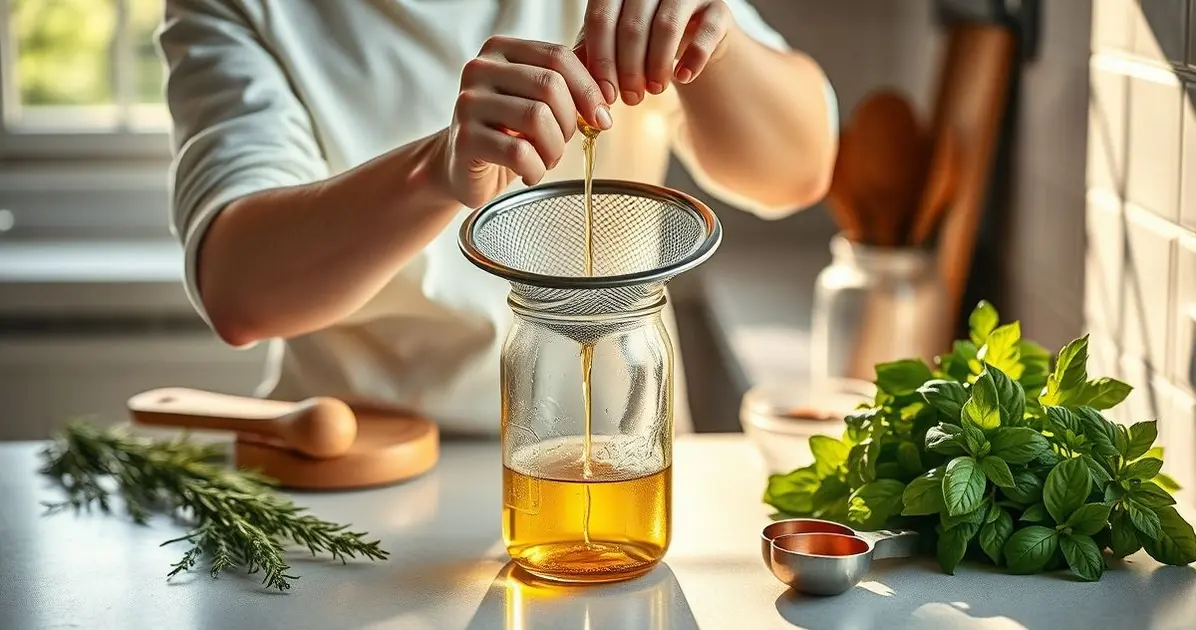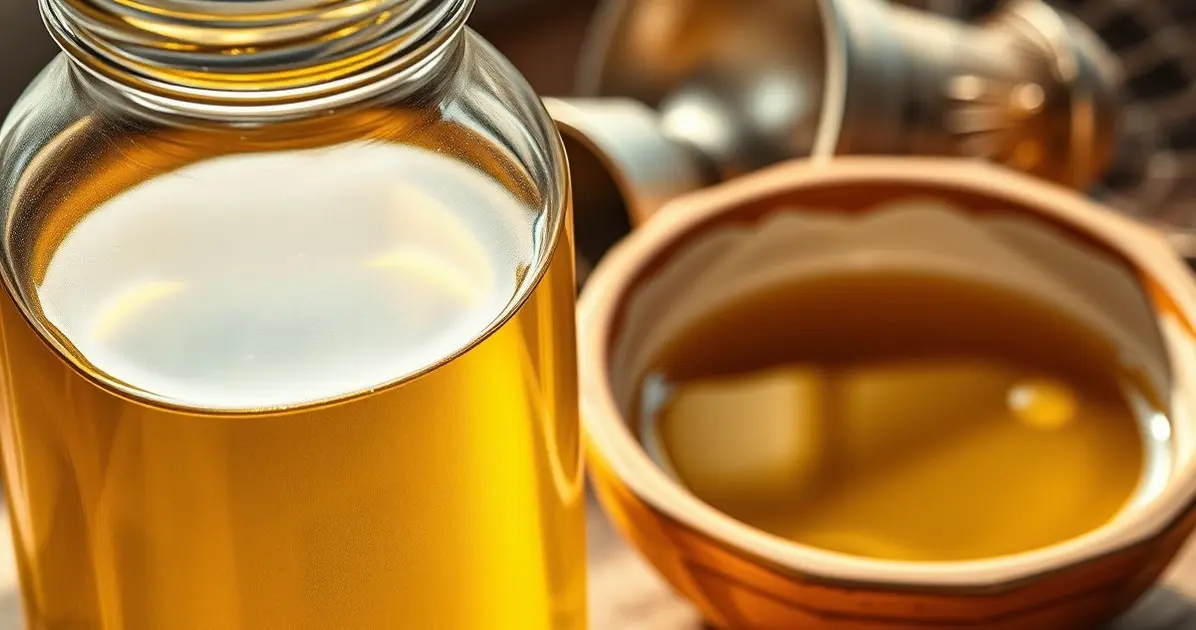Cleaning used cooking oil is essential for safe reuse in cooking or for disposal. It enhances flavor and prolongs oil life, making it a sustainable kitchen practice. Here’s a guide on how to effectively clean it.
How to clean used cooking oil

To clean used cooking oil, allow it to cool, then filter it through a fine mesh strainer or cheesecloth to remove food particles. Store it in a clean, dry container. Proper cleaning not only preserves flavor but also reduces waste.
Techniques for Filtering Cooking Oil
When it comes to filtering cooking oil, there are several techniques you can use to ensure it’s clean and safe for reuse. Here are some effective methods:
- Fine Mesh Strainer: This is one of the simplest methods. A fine mesh strainer can catch larger food particles, making it a great first step in the filtering process. Just pour the used oil through the strainer into a bowl or pot.
- Cheesecloth: For finer filtration, cheesecloth is an excellent option. After straining the oil with a fine mesh strainer, line the strainer with cheesecloth to catch smaller particles. This will give you cleaner oil for reuse.
- Coffee Filter: Similar to cheesecloth, a coffee filter can be used for fine filtration. Place it in the strainer and pour the oil through. It may take a bit longer, but it effectively removes tiny impurities and sediments.
- Activated Charcoal: Adding activated charcoal to your oil can enhance the filtering process. This method helps absorb odors and additional impurities. Simply mix in some activated charcoal, let it sit for about 30 minutes, and then strain the oil again.
- Decanting: If the oil has settled, you can carefully pour the clear oil from the top, leaving sediment at the bottom. This method works well if the oil hasn’t been overly contaminated.
Each of these techniques offers a different level of filtration, so you can choose the one that best suits your needs. Combining methods can also yield the best results, ensuring your cooking oil is as clean as possible for future use.
Using a Fine Mesh Strainer
Using a fine mesh strainer is one of the most straightforward and effective methods for filtering used cooking oil. Here’s how to do it properly:
- Choose the Right Strainer: Select a fine mesh strainer that has small enough holes to catch larger food particles. The finer the mesh, the better it will filter out debris. You can find these strainers at most kitchen supply stores.
- Prepare Your Workspace: Before you start, make sure your workspace is clean. Have a bowl or pot ready to catch the oil as you strain it. This will help prevent spills and keep everything tidy.
- Let the Oil Cool: After cooking, allow the oil to cool to a safe temperature. Hot oil can be dangerous and difficult to handle. Once it’s cooled, you’re ready to filter.
- Strain the Oil: Carefully pour the cooled oil into the fine mesh strainer positioned over your bowl or pot. Take your time to avoid splashes. The strainer will catch larger food particles, allowing the cleaner oil to pass through.
- Dispose of the Residue: After straining, you’ll be left with food particles in the strainer. Dispose of these in your compost or trash. Make sure to clean the strainer thoroughly after use to prevent any lingering odors or residue.
Using a fine mesh strainer is a quick and efficient way to start the oil purification process. It’s an essential first step that sets the stage for further filtration methods, ensuring your oil is ready for reuse.

Tips for Storing Cleaned Oil
Storing cleaned cooking oil properly is crucial to maintain its quality and ensure it remains safe for reuse. Here are some essential tips for storing your cleaned oil:
- Use Clean Containers: Always store your cleaned oil in a clean, dry container. Glass jars or dark plastic bottles work best. Avoid using containers that previously held food items, as residues can affect the oil’s quality.
- Choose Opaque or Dark Containers: Light can cause cooking oil to degrade over time. Opt for opaque or dark-colored containers that block out light, helping to preserve the oil’s freshness and flavor.
- Label Your Containers: Clearly label each container with the type of oil and the date it was cleaned. This helps you keep track of freshness and ensures you use older oils first.
- Store in a Cool, Dry Place: Keep your cleaned oil in a cool, dry location away from direct sunlight and heat sources. A pantry or cupboard is ideal. Avoid storing oil near the stove or oven, where temperatures can fluctuate.
- Check for Quality Before Use: Before reusing stored oil, always check for any off smells or changes in color. If the oil smells rancid or has an unusual appearance, it’s best to dispose of it.
By following these tips, you can extend the life of your cleaned cooking oil and ensure it’s safe and ready for your next culinary adventure!
Eco-Friendly Disposal Options
When it comes to disposing of used cooking oil, it’s important to do so in an environmentally friendly manner. Here are some eco-friendly disposal options to consider:
- Recycle Cooking Oil: Many recycling centers accept used cooking oil. They can convert it into biodiesel or other renewable energy sources. Check with your local recycling facility to see if they accept cooking oil and their specific guidelines for drop-off.
- Compost It: If the oil is in small quantities and derived from plant-based sources (like vegetable oil), you can add it to your compost pile. Be sure to mix it well with other compost materials to avoid attracting pests.
- Use It for Animal Feed: Some farms and animal shelters may accept small amounts of used cooking oil for animal feed. Contact local farms to see if they have a need for it. Ensure the oil is free from harmful additives and chemicals before offering it.
- Seal and Dispose in Trash: If recycling or composting isn’t an option, seal the used cooking oil in a container (like a bottle or jar) and dispose of it in the trash. Make sure the container is tightly sealed to prevent leaks.
- Check for Local Disposal Programs: Some communities have specific programs for disposing of cooking oil, especially during certain times of the year (like after the holidays). Research local waste management services to see if they offer special collection events.
By choosing these eco-friendly disposal options, you can minimize your environmental impact and contribute to a more sustainable future. Proper disposal of used cooking oil not only helps the planet but also keeps your community clean!
Conclusion
Cleaning and reusing cooking oil is not only a cost-effective practice but also an environmentally responsible choice.
By following the simple steps outlined in this guide, such as using techniques like a fine mesh strainer and activated charcoal, you can ensure your oil is safe for reuse.
Proper storage is key to maintaining its quality, so use clean, opaque containers and store them in a cool, dry place.
Additionally, when it comes time to dispose of used oil, consider eco-friendly options like recycling or composting, which help reduce waste and contribute to a sustainable environment.
By adopting these practices, you not only extend the life of your cooking oil but also play a part in protecting our planet.
FAQ – Frequently Asked Questions about Cleaning Used Cooking Oil
How often can I reuse cooking oil?
You can reuse cooking oil a few times, depending on how it’s been used and how well it’s been cleaned. Always check for off smells or changes in color before reusing.
What is the best method to clean used cooking oil?
Using a combination of a fine mesh strainer followed by cheesecloth or coffee filters is one of the best methods to effectively clean used cooking oil.
How should I store cleaned cooking oil?
Store cleaned cooking oil in a clean, dry, opaque container in a cool, dark place to maintain its quality.
What should I do if the oil smells bad?
If the oil smells rancid or has an unusual appearance, it’s best to dispose of it rather than reuse it.
Can I compost used cooking oil?
You can compost small amounts of plant-based oils, but be sure to mix them well with other compost materials to avoid attracting pests.
What are some eco-friendly disposal options for used cooking oil?
Eco-friendly options include recycling at a local facility, composting, or sealing it in a container and disposing of it in the trash.
See more
Discover plenty of easy and delicious recipes you can make at home, from hearty dinners to indulgent desserts and wholesome breakfasts.




